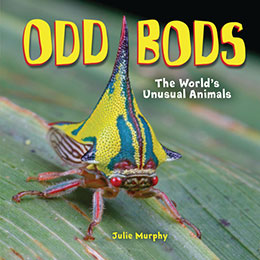 One of my favorite nonfiction picture books so far this year is Odd Bods: the World’s Unusual Animals by Julie Murphy.
One of my favorite nonfiction picture books so far this year is Odd Bods: the World’s Unusual Animals by Julie Murphy.
Here’s a brief description:
Long snouts, bright-red lips, pointy heads … the animal kingdom is full of critters with unique features. Learn about the incredible adaptations that help these animals – and their odd bods – survive and thrive all around the globe!
Why do I love this book so much? Because it’s loaded with kid appeal. The fun, rhyming title will hook even the most skeptical young readers and the colorful design will invite them to dive in.
Kids often say they prefer books with photos (rather than illustrations) because “then I know it’s real,” and the images in this book don’t disappoint. Captivating close-ups of red-lipped batfish, naked mole rats, and lizards known as thorny devils are sure to delight curious kids.
While the text of this expository literature list book is simple enough for most grade 2 students to tackle on their own, it’s jampacked with vibrant verbs, alliteration, and onomatopoeia that make the book a pleasure to read. For example, when discussing the critical traits of an odd-looking bird called the shoebill, Murphy writes, “A hefty, hooked beak and scary stare can be fierce features!”
To craft the book’s lively, playful voice, author Julie Murphy also makes excellent use of second-person narration rhetorical questions, surprising adjectives, and the interruption construction. For example, when describing the naked mole rat, Murphy writes, “For rare chilly snap, this wrinkly rodent huddles with its large family. Who doesn’t love a cuddle once in a while?”
Sandwiched between an intriguing introduction and a satisfying ending, eleven spreads with layered text allow readers to compare and contrast a range of unusual animal from all over the world. The larger main text highlights each critter’s most notable feature in a single sentence, while more extensive secondary text set at a smaller size provides additional details.
The backmatter includes a map showing where all the featured animals live, key facts about each critter, and a list of additional books and websites kids can explore to learn event more.
Book talk Odd Bods once, and it’ll become one of the most popular titles in your classroom or library book collection. It’s a great choice for read alouds and book clubs, and it can easily be integrated into science lessons or used as a mentor text during units on informational writing.

Thank you for your insightful review of Odd Bods, Melissa. To read such words from one of my absolute nonfiction heroes has made my decade! Thanks for working so hard to promote children’s nonfiction books.